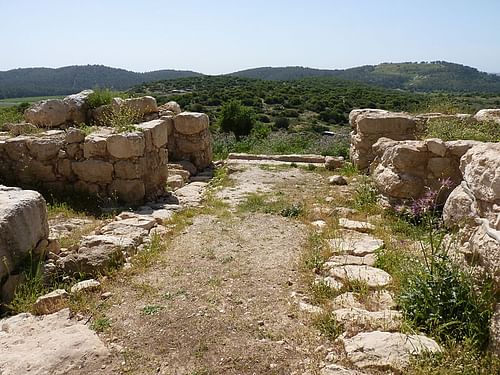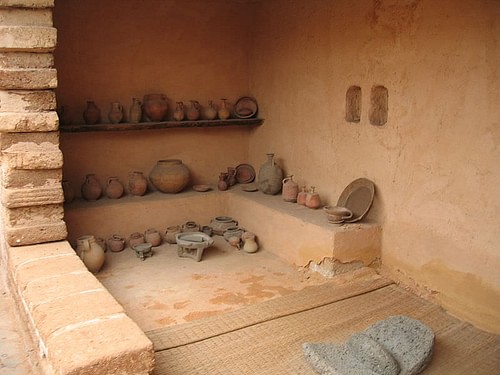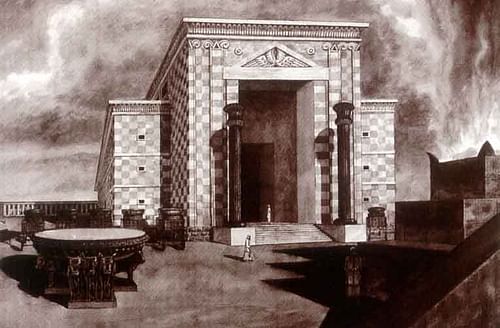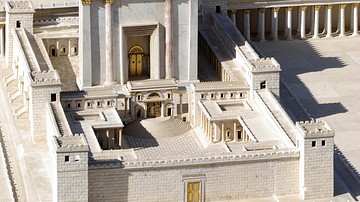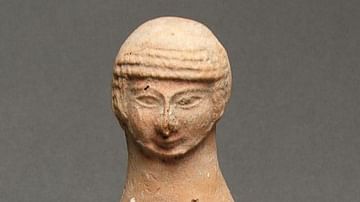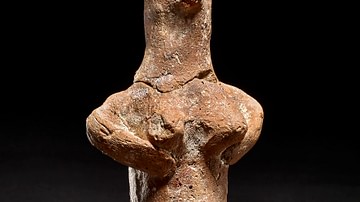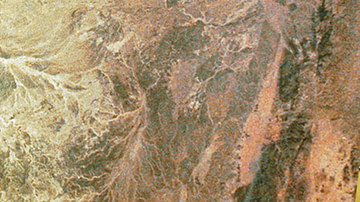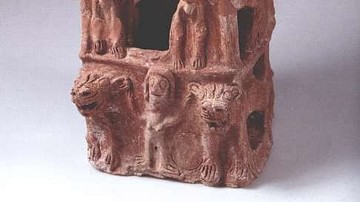As early as the 10th century BCE, Israelite and Judean religion began to emerge within the broader West Semitic culture, otherwise known as Canaanite culture. Between the 10th century and 7th centuries BCE, ancient Israelite and Judean religion was polytheistic. The polytheism, though, was counterbalanced by devotion to one or two primary deities, a practice known as henotheism (van der Toorn, 2047). Henotheism is recognition and worship of many deities; however, the primary worship revolves around a single deity. Within Judean and Israelite communities, primary devotion was oftentimes towards Yahweh. As both Judah and Israel were emerging states, Yahweh was the national deity, an idea which finds its origins in religious practices from the Bronze Age.

In terms of practice, temple worship and sacrificial rituals like Yom Kippur, New Moon festivals, Pesach, and other festivals played a central role. Practices such as divination and prophecy were also common forms of religious devotion. In terms of actions, ethical behavior played an important role in how ancient Israelite and Judeans expressed religious devotion.
In the following paragraphs, we will explore the aforementioned aspects of ancient Israelite and Judean religion in more detail. Focused between the 10th and 7th centuries BCE, we will consider the broader West Semitic cultural framework, family religion, henotheism, ritual, and ethical behavior.
The Broader West Semitic Context
Between the 10th and 7th centuries BCE, ancient Israelite and Judean religion took place in cultic and temple contexts. Although the many Jewish and Christians traditions suggest that Yahweh was the main and only deity through all Israelite and Judean religious history, archaeology, inscriptions, and the Hebrew Bible itself indicate otherwise. Even so, the deity being worshiped, usually Yahweh, was understood to be physically present in the temple, have a body, and be a personal god with emotions and willpower.
Furthermore, ancient Israelite and Judean religion shared the common idea that the deity was a divine essence. This divine essence was often expressed through the notion of holiness. So, the worshippers were required to maintain the temple's holiness so that the deity would be able to live in the temple, which was considered his or her house. To do this, sacrifices, offerings, and liturgy were offered to the deities. Broadly speaking, these form a basic framework for how ancient Israelites and Judeans expressed religious devotion to their deity.
Before Saul & David
Before a centralized authority or state began to take formation around the 10th century BCE, people within Syria-Palestine practiced a form of family religion. Literature dating back to the 12th century BCE (1200 BCE; Amarna letters) and various inscriptions throughout Syria-Palestine demonstrate this. The data, though, is fragmentary. In other words, it is as if we have 400 pieces to a 2,000-piece puzzle. Yet, when we connect the puzzle with other historical sources from history, it becomes clear that family religion was the norm as Israel and Judah began forming a national identity. Thus, it is possible that "families honoured their ancestors by verbal rites and the presentation of offerings, and focused their religious devotion on the 'god of the father' or the 'god of the house'. In so doing, they anchored their collective identity in their lineage and their place of origin" (van der Toorn, 1996: 177).
This was the atmosphere, or context, in which ancient Israelite and Judean religion began to emerge. What to call the people before the formation of Israelite and Judean national identities, though, is hotly debated. For simplicity's sake, then, we will refer to them as proto-Israelite. Assuming the Hebrew Bible reflects proto-Israelite religion, some scholars suspect that they performed rituals in honor of the deceased. Drawing on an example in 1 Samuel 20, van der Toorn explains:
What we learn from the passage is that there was a communal meal at which meat was eaten…; that the 'entire clan'… had to be present; that it was celebrated in Bethlehem, the home town of David, presumably because this was the place where the claim had its inherited land in which the ancestors lay buried… On the basis of this data, it has been suggested that the … clan sacrifice was in fact 'the occasion on which genealogical accounts were employed to invoke the names of dead ancestors.' (214)
In other words, it is likely that proto-Israelites practiced some sort of clan or family ritual. As ancient Israelite and Judean religion moved closer and closer to monotheism between the 10th and 6th centuries BCE, the notion of a family religion became incorporated into ancient Judah. The idea of the house of Israel or the house of Judah is rooted in the idea of family religion. With the emergence of a larger network of political alliances under the titles Israel and Judah, though, the family deity became the deity of the state.
Henotheism
Outside of the Hebrew Bible, one of the best examples of ancient Israelite and Judean religion comes from an archaeological site called Kuntillet 'Ajrud, possibly dating as early as the 10th century BCE. One inscription from this site reads, "to YHWH of Samaria and to Asherata." Another inscription reads, "To YHWH of Teman and to Asherata" (Na'aman, 305). Both of these inscriptions demonstrate that some ancient Israelites and Judeans were not monotheistic in how they practiced religion; rather, they were henotheistic. YHWH, which may be read as Yahweh, was the primary tribal deity. He is best known from the Hebrew Bible. Asherata, also known as Asherah, was a deity within the Ugaritic pantheon. She is also a common figure in the Hebrew Bible. Therefore, we can confidently say that among the spectrums of how people in ancient Israel and Judah practiced religion, Asherah and Yahweh were both honored in cults. Priority, though, tended to be given to Yahweh.
An inscription from another archaeological site (Khirbet el-Qom, 8th century BCE) says the following: "Blessed is Uriahu by YHWH for through Asherata He saved him from his enemy." Here, we see strong evidence that Asherata, a deity, represented a person named Uriahu before Yahweh. In Ugaritic literature, we see a similar understanding of the deities. The Ugaritic goddess Athirat was a mediator for El, the chief god of the Ugaritic pantheon. The parallel in how people understood deities (Yahweh is to Asherata as El is to Athirat) demonstrates how ancient Israel and Judah shared a cultural and religious framework with the broader West Semitic culture; yet, they were also unique in the sense that they worshiped a particular deity who uniquely represented their tribal system(s). Notably, though, this interpretation is still debated in current scholarly discussion (See Smith 2002, 125; Smith 2001, 72-73).
Other examples come from the Hebrew Bible itself. In Psalm 82, for example, Yahweh stands in the council of El, the high deity in West Semitic mythology. Yahweh accuses the other deities in the council of not helping poor and needy. In other words, the other deities failed to do their jobs as deities. As a result, El takes away the divine status of the deities and commands Yahweh to rule over the nations. In this piece of poetry from Judah and Israel, we have an example of a tradition in which other deities are within the pantheon; however, Yahweh takes the central role.
Narrative in the Hebrew Bible tells a similar story. For example, in 1 Kings 16:33, King Ahab makes a shrine for Asherah. 2 Kings 17:16 even references people who worship Asherah and Baal. Likewise, Baal worship occurs consistently throughout the narrative, suggesting that he "played a large part in the belief of the Israelite population" during the Iron Age (DDD 1999, 137).
Additionally, one of the earliest translations of the Hebrew Bible into another language in the 3rd century BCE attests to the henotheism of ancient Israel. In the Septuigant (LXX), a Greek translation of the Hebrew Bible, Deuteronomy 32:8 reads: "When the Most High was apportioning nations, as he scattered Adam's sons, he fixed boundaries of nations according to the number of divine sons" (Pietersma and Wright, 2007). Most High is a reference to El. In this verse, El is said to assign nations and people groups to his divine sons, namely deities. In this verse, Yahweh is assigned to Israel, and other deities to other peoples. Thus, the Hebrew Bible itself reflects the henotheism of ancient Israel and the region more broadly.
And as the previous inscriptions demonstrate, worship of deities other than Yahweh seems to have been a regular part of life for people. Throughout the Hebrew Bible, it suggests that Yahweh has always been the deity that people should worship. Based on these inscriptions, Psalms, Kings, Deuteronomy, and other unmentioned evidence, though, we know this is not the case; rather, henotheism was likely the norm for ancient Israelites and Judeans.
One scholar suggests that "whatever the biblical authors may have tried to convey, may not have been… the primary form of belief or religious exercise" (Gilmour, 100). In other words, the Hebrew Bible does not accurately represent how people actually practiced religion in the ancient world. He claims this because the Hebrew Bible itself was likely edited and compiled between the 7th and 3rd centuries BCE. So, although the Hebrew Bible preserves traditions going back as far as the 11th century BCE, the theological and cultural positions between the 7th and 3rd centuries BCE were likely read into the past and, among these, was monotheism.
Practice & Ritual
Having offered a basic idea of what and how some ancient Israelites and Judeans may have thought about their deities, we can now look at how ancient Judeans and Israelites practiced religion within their material environment. In other words, what sort of things did they physically do in order to worship their primary deity, Yahweh?
According to tradition in the book of Leviticus, there were 5 main types of sacrifice: burnt offering, grain offering, wellbeing offering, sin offering, and guilt offering. Within each type of sacrifice, there were three levels of material objects which could be offered. The reason there were three levels was to enable the poor within the society to offer sacrifice. For example, a person bringing a burnt offering could offer a bull, sheep or goat, or turtledove or pigeon. In other words, they could offer an expensive offering, a medium-priced offering, or an inexpensive offering. The other types of sacrifices offered the same opportunity for the poor. Some ritual texts from a Syrian city called Emar include the same levels of sacrifice, namely levels which enabled the poor to make offerings.
One of the most important annual rituals may have been the Day of Atonement (Yom Kippur). The purpose of the Day of Atonement was to purify the sanctuary; for sin was thought to pollute the sanctuary. Without the ritual, Yahweh would, potentially, leave the sanctuary. Without Yahweh in the sanctuary, there was no longer any deity to advocate for the Judean population. As part of the assembly of El, the high god in Ugaritic mythology (cf. Ps. 29, 82), Yahweh was "assigned" Israel in some biblical traditions.
In order to solve this potential problem, a high priest would perform the sacrificial ritual by sacrificing for the sins of the people and sprinkling blood upon the altar. He then placed his hand on the head of a goat, transferred the impurities to the goat, and made one final burnt offering to atone for the people (Leviticus 16). Consequently, the people were atoned for. This national atonement also served to strengthen political bonds and unity.
The Day of Atonement is very similar to a ritual in Ugaritic texts (KTU 1.40), which date around the 13th century BCE. It does differ, though, in one major way. Whereas the Ugaritic ritual is performed in multiple temples, the Day of Atonement is, according to Leviticus, only performed in one temple, one sanctuary. Thus, ancient Israelite and Judean religion shares a similar ritual framework; however, the ritual is also distinct from other West Semitic rituals in terms of the centrality around one sanctuary.
Of course, other rituals are also attested to throughout the Hebrew Bible, such as Passover (Pesach), New Moon festivals, and other festivals to celebrate seasonal changes. These rituals likely involved sacrifice to Yahweh, just like the tradition of the Day of Atonement.
Ritual was not the only form of religious devotion, however. Although oftentimes considered to be taboo, divination was an important part of ancient Israelite and Judean religion. For example, 1 Samuel 28 tells a narrative of King Saul visiting a necromancer (one who raises ghosts from the ground) at En-dor. King Saul needs to speak to Samuel the prophet's ghost. In this passage, though, the witch is not condemned for performing necromancy. Thus, this text demonstrates that divination did occur in ancient Israelite and Judean practice and ritual. Likewise, it was not necessarily frowned upon.
At the same time, some traditions explicitly ban divination. In Deuteronomy 18:10-11, the push against divination is explicit: "Let no one be found among you who consigns his son or daughter to the fire, or who is an augur, a soothsayer, a diviner, a sorcerer, one who casts spells, or one who consults ghosts or familiar spirits, or one who inquires of the dead." There would be no reason for a law such as this, though, if divination was not practiced. Therefore, ancient Israelite and Judean religion includes divination in some traditions; however, other traditions, such as Deut. 18:10-11, stand in opposition to the practice of divination.
Ethics
In the ancient world, ethical behavior played an important role in religion. The first five books of the Hebrew Bible, for example, emphasize the importance of ethical behavior. The ethical behavior, though, is not a distinct category from religion in the ancient world; rather, ethical behavior impacts whether or not the deity, namely Yahweh, resides in the sanctuary or temple. Consequently, ethical behavior was understood to be correlated with whether or not Yahweh continued protecting the ancient Judeans and Israelites from other people groups. This sort of correlation is evident throughout the Hebrew Bible.
For example, a group on Mount Samaria is referenced as "the ones who oppress the poor and crush the needy" (Amos 4:1). In response, Yahweh claims that even though he removed their food, sent no rain, and caused famine, the people did not return. In other words, they did not change their behavior. This does not indicate that Yahweh only cared about ethics and did not care about his cult; rather, it indicates that ethics impacted whether or not Yahweh would provide sustenance for the people. Another example is in 1 Samuel 4. In this narrative, the glory of Yahweh, namely the representation of his physical presence, leaves the temple as a consequence for the ethical corruption of the sons of Eli. Finally, Leviticus 18-22 offers a series of moral and ethical standards. The consequence of not following the standards is being "cut off from the people." Importantly, though, this consequence is not the punishment for bad behavior; rather, the consequence is necessary in order to maintain sanctity and holiness within the community and of the temple. For, if the house of Yahweh became too polluted, he would have to leave.
Thus, the ethical behavior of the Judean peoples was an important aspect of religion because it ensured the enduring presence of the deity in the temple. Consequently, the deity was able to provide blessings, life, and sustenance from the temple.
History in the Hebrew Bible, Judaism, & Current State of Scholarship
People familiar with the Hebrew Bible/Old Testament may have noticed that there was no discussion about the religious importance of aspects like the Law, Moses, and the Davidic Dynasty. The reason such religious aspects were not included was that these reflect religious ideas developed between the 7th and 4th centuries BCE. While the line of Judah and figures like David existed, they were not necessarily central to ancient Israelite and Judean religious practice. For, "the presentation of Israel's past in the biblical narrative from Genesis to 2 Kings is an ideological construct by intellectuals" after the 7th century BCE "who, nevertheless, transmitted some memories dating from the tenth to the sixth centuries BCE" (Knauf and Guillaume, 53). Thus, to a certain extent, the Hebrew Bible reflects well the past in ancient Judah and Israel; however, as a compilation of Judean traditions, it sometimes misrepresents or altogether ignores what happened in the past.
Additionally, attentive readers may notice that there was no discussion of Judaism. Generally speaking, the scholarly consensus is that the religion of Judaism was distinct from ancient Israelite and Judean religion. The elements which define Judaism, though, are beyond the scope of this article.
Finally, it is important to be aware of the current state of scholarship regarding ancient Israelite history. As a field of study, it is one of the most challenging fields because scholars have a limited amount of primary sources they can work with. Likewise, ancient Israelite history, particularly the religious history, is difficult to work with because one must sift through the Hebrew Bible in order to decide what may reflect the past most accurately. So, there may be others who offer vastly different explanations and descriptions of how ancient Israelites and Judeans practiced religion. This is a natural consequence of the sparse amount of data and serves to exemplify how much more research needs to be done in ancient Israelite history in order for us to be able to appreciate how this ancient people group understood their role in the world.
